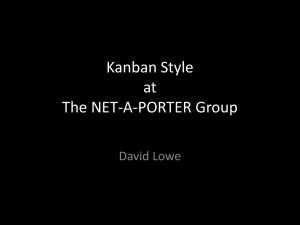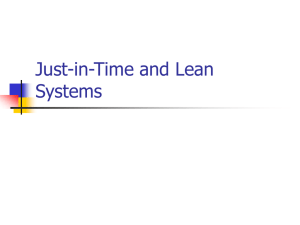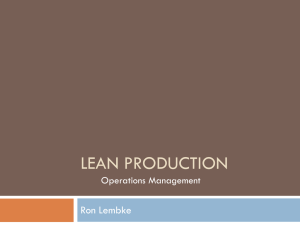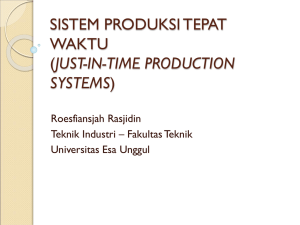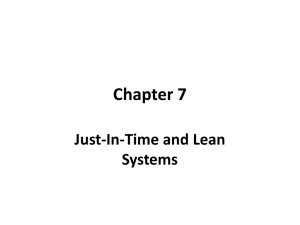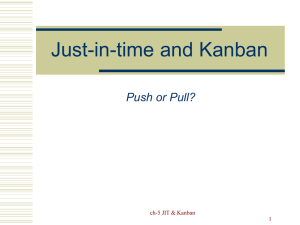Document
advertisement
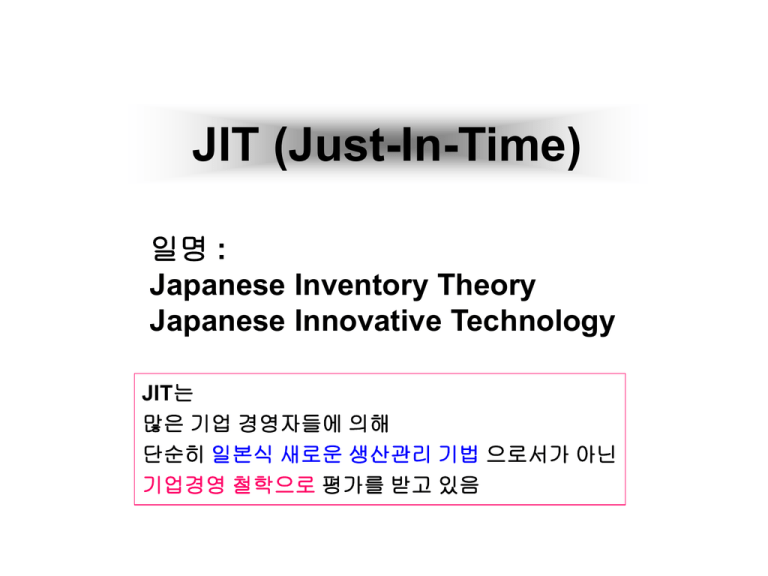
JIT (Just-In-Time) 일명 : Japanese Inventory Theory Japanese Innovative Technology JIT는 많은 기업 경영자들에 의해 단순히 일본식 새로운 생산관리 기법 으로서가 아닌 기업경영 철학으로 평가를 받고 있음 생산현장 (Shop Floor)은 어떤 모습일까? Workstation 원자재 Bottleneck공정 UPSTREAM workstation 공정재고 Work-In-Process(WIP) DOWNSTREAM workstation 고객 수요 최종제품 재고 JIT의 기원 1945년 도요타 자동차㈜의 회장 Toyota Kiichiro의 기업비전 = Catch up with America in three years. Otherwise, the automobile industry of Japan will not survive. •그 당시 일본의 노동생산성 (labor productivity)은 미국의 1/9 •생산자동화 수준은 미비 한편, 미국의 자동차 산업은 20세기 초반 Fredrick Taylor에 의해 시작된 Scientific Management 와 1920년대 Henry Ford에 의해 주창된 ‘Speed & Mass Production”의 기치하에 세계 자동차 시장을 석권하고 있었음 (20년대 ‘Speed & Mass Production”의 기치하에 제작된 포드사의 T모델은 미국자동차 시장의 1/3을 석권 & 전체적으로 포드사의 미국내 자동차시장 점 유율은 2/3.) 도요타는 기업비전을 달성하기 위하여 생산성 향상 & Waste Elimination 에 회사의 총력을 기울임 그 결과 3년후에 미국에 자동차회사들을 따라 잡을 수 있었을까요? JIT의 기원 도요타는 생산성향상을 통해 대량생산과 비용절감을 가능하게 하고 이를 통해 자동차 가격 경쟁력을 확보하고자 했으나 일본 자동차시장의 규모의 제한으로 인해 규모의 경제를 달성하는데 실패 Taiichi Ohno의 등장 광범위 •비즈니스 전략의 수정 : ‘Produce many models in small numbers’ •위 전략을 달성하기 위한 생산전략 제시 : Just-In-Time Automation with a Human Touch 집중화 비용우위 차별화 Ohno의 JIT 아이디어는 50년대 중반 일본에 선보인 미국식 대형 supermarket에서 나옴 밀어내기식(PUSH) 제품 충원방식이 아닌 고객이 제품을 구입해가면 구입해 간 양만큼 해당 제품코너를 채우는 방식 (PULL) = JIT의 핵심 JIT가 꿈꾸는 Utopia Workstation 원자재 Bottleneck공정 공정재고 Work-In-Process(WIP) Zero inventories 고객 수요 최종제품 재고 JIT Goals – Seven zeros ZERO DEFECTS – JIT는 zero inventory를 지향하므로 최소한의 공정재고를 가져가야 함. 따라서 불량 부품이 발생하면 전 공정을 멈추어야 하는 상황 발생 ZERO (EXCESS) LOT SIZE – lot size of 1을 지향. Downstream w/s이 부품을 가져갈 때마다 생산을 해야 하므로 lot size가 크다면 JIT는 무의미 ZERO SETUPS – many models in small numbers를 하기 위해서는 많은 회수의 생산 setup이 필요한데 setup에 시간이 걸린다면 JIT는 무의미 ZERO BREAKDOWNS – 최소한의 공정재고를 가져가야 하므로 특정 W/S의 고장은 전체 생산라인의 all stop을 의미 ZERO HANDLING – 부품들이 적시에 적량으로 만들어 지기 때문에 부품 핸들링에 따른 시간/노력이 최소가 됨 ZERO LEAD TIME – Downstream w/s이 부품들을 요구하게 되면 즉시 제공받을 수 있어야 하므로 Upstream w/s는 최소한의 Lead time을 가져가야 함 ZERO surging – 최소한의 공정재고를 가져가야 하므로 갑작스런 생산량/계획 편차/변경은 JIT를 무의미하게 만듦. 균형잡힌 생산계획은 JIT의 중요한 Input. Metaphorical Writing on Zero Inventories : The Toyota production wrings water out of towels that are already dry. There is nothing more important than planting “trees of will”. --- Shingo 1990 JIT Implementation을 위한 전제 조건 Kanban Production Smoothing Total Quality Management (TQM) Cross Training and Plant Layout JIT Implementation – Kanban JIT는 Kanbans (or cards)을 이용하여 생산 공정 (공정 시작시간, 공정재 고(WIP)의 크기 등)을 통제함 PUSH system (예: MRP) Schedules work releases – 사전에 결정된 생산 스케쥴에 의해 공정 이 시작되고, 한번 시작이 되면 가공해야 할 부품이 남아 있는 한 생 산은 계속됨 PULL system (Kanban) Authorizes work releases – ‘생산을 해도 좋다’라는 허락이 있어야 지만 공정이 시작되고, 허락한 수량만큼만 생산함. ‘생산을 해도 좋 다’라는 허락은 Downstream에서 Demand가 발생하면 생성됨 Kanban의 종류: Two-card system : - Production cards - Move cards One-card system One-card Kanban System 반제품 Kanban 공정1 공정이 완료된 반제품은 Kanban이 부착된 상태로 재고로 보관 공정2 공정3 공정3에서 재고를 가져가면서 Kanban이 제거가 되고 상자에 놓이게 됨 Kanban을 보관하는 상자 상자안에 Kanban이 놓이게 되면 공정2는 공정1에 있는 반제품 재고를 가져와서 Kanban을 부착시키고 생산시작 JIT Implementation – Production Smoothing MPS의 11월 제품소요 계획 제품 종류 Demand A 5,000 (50%) B 2,500 (25%) C 2,500 (25%) 생산라인의 일일 생산 능력 = 500 한달 조업 일수 = 20일 대안1 : 처음 10일 동안 제품A, 다음 5일은 제품B, 마지막 5일은 제품C생산 JIT : 일일 생산 능력 500을 제품별로 나눔 제품A = 250, 제품B = 125, 제품C = 125 제품생산순서를 Demand 비율을 고려하여 정함 A-B-A-C-A-B-A-C-A-B-A-C-A-B-A-C-A-B-A-C-A-B-A-C… JIT Implementation – Production Smoothing 일반 계획생산 동일한 제품은 한꺼번에 모아서 생산 평준화 생산 1개월간의 생산계획을 가능한 평균 적으로 배분하여 생산하는 형태. 일반 계획 생산 평준화 생산 1. 한꺼번에 모아서 대단위로 생산하므로 해당 LINE의 생산성은 높아짐 1. 전(Upstream), 후(Downstream) 공정재고를 최소화할 수 있음 2. 생산 setup 회수가 줄어듦 2. 고객 요구에 대응하기 용이함 (표 1) JIT에 의한 생산공정의 비교 비교 일본 Setup 시간 Setup 회수 Lot Size 10분 3회/일 1일분 미국 스웨덴 6시간 4시간 1회/일 1회/월 10일분 1개월분 독일 4시간 0.5회/일 - 자료:Chase, R.B. and Aquilano, N.J., Production & Operation Management, Ricard D. Irwin Inc., 1985, p.726 JIT Implementation – TQM JIT가 성공할 수 있었던 가장 큰 요인은 high-level of quality를 demanding 하는 구조 품질과 관련된 JIT의 7대 원칙 = Total quality management Process control – SPC, workers’ responsibility Easy-to-see quality – put quality on display Insistence on compliance – quality comes first Line stop – each worker has right to stop the line Correct your own errors – Rework yourself The 100% check – Inspect every part Continual improvement – Ideal of zero defects JIT Implementation – Cross Training and Plant Layout Multifunctional workers: Can operate multiple machines at once or when needed 작업자들은 다재다능해야 함 U-type manufacturing cells Smooth and fast flow from one machine to the next Operator can monitor entering and leaving parts, and machines at the same time, without too much walking Inbound Stock Outbound Stock 80년대 자동차 산업에서의 JIT v.s. MRP MRP 1980년대 JIT 미국 자동차 회사들의 경쟁력 일본 자동차 회사들의 경쟁력 Lower Level Inventory Lower Level Inventory MRP … Assembly … Assembly Kanban … Kanban Signals Full Containers JIT – 논쟁 포인트 Transportable (이식성)? Schonberger (1982) - I believe that the approaches travel easily to other countries… works in non-Japanese settings. Monden(1983) & Hall (1983) Robert Hayes (1981) - In a tour of 6 Japanese facilities, he wrote he found “no exotic, strikingly different Japanese way of doing things”. Toyota Kanban system is almost exclusive to Toyota. JIT에 대해서 왜 이런 상반된 견해가 나오게 되었을까? 사람들마다 JIT에 대한 이해가 달랐기 때문 A system of Beliefs V.S. A collection of methods Mortals Emulating Genius Persistence: Toyota took 25 years to reduce setups from 2-3 hours to 3 minutes. Environmental Factors: Harder to address than direct procedures. Some people imagine that Toyota has put on a smart new set of clothes, the kanban system, so they go out and purchase the same outfit and try it on. They quickly discover that they are much too fat to wear it. --- Shingo Prioritization: Systems view is first thing to get lost. Deliberate obfuscation? If the U.S. had understood what Toyota was doing, it would have been no good for us. --- Ohno JIT – 끝없는 논쟁 A system of Beliefs V.S. A collection of methods 학계와 기업, 학계내 전문가들 사이에서 많은 논란이 벌어짐 도요타의 Ohno회장- “If the U.S. had understood what Toyota was doing, it would have been no good for us.” (1990) 의도적으로 JIT의 모호성을 가져갔던 것에 대해 시인!!! 80년대 90년대 이후 A system of Beliefs < A collection of methods A system of Beliefs > A collection of methods JIT - Implementation에 따른 문제점 JIT는 널리 알려진 몇몇 성공적인 사례에도 불구하고, 기업이 도입하기에는 Neither Simple nor Inexpensive! A collection of methods •JIT 도입과 관련해서 체계화된 절차가 없음 •JIT를 정확히 이해하고 있는 전문가가 해당 기업내에 전무 •외부 전문가의 참여를 통해 실행하기에는 많은 비용과 시간이 들어감 A system of Beliefs •전사의 업무 수행에 따른 사고의 전환을 필요로 함 JIT는 중소기업이 도입할 수 있는 역량을 벗어남 (JIT is beyond the reach of many small companies, Inman & Mehra(1990)) 이론의 여지가 없는 JIT의 최대 성과 Total Quality Management Low inventory production cannot be implemented without good quality & Good quality is impossible without low inventory and short production cycle times! – Hopp & Speaman 90년대 미국 기업에서의 JIT JIT는 Implement 관점에서 매우 정교한 Human Interface가 필요한 Kanban 시스템을 요구함 Kanban 시스템은 생산라인의 각각의 workstation별로 운영이 되어야 함 이러한 Kanban 시스템은 미국사람들 정서에 맞았을까? Wallace Hopp & Mark Spearman (1989) -Kanban의 장점과 미국식 합리주의를 mix한 새로운 형태의 생산공정 관 리 방식인 CONWIP (Constant Work-in-Process)을 발표함 -CONWIP을 집대성한 “Factory Physics”로 Book of the Year 상을 받음 -많은 학자들에 의해 CONWIP이 JIT보다 더 나은 생산공정관리 방식 이 라는 연구 결과가 발표되었음 MRP Lower Level Inventory … Assembly … Assembly Kanban Lower Level Inventory … Kanban Signals Lower Level Inventory 첫 공정이 언제 시작되는가? Full Containers CONWIP … Assembly 마지막 공정으로 부터 생산 지시카드를 받으면 Push Production Systems V.S. Pull Systems Push Systems (MRP) •High WIP •High lead times •High inspection and rework costs •Lower quality levels •Production problems are blanked by high WIP levels Pull Systems (Kanban & CONWIP) •Lower WIP •High quality •Higher customer responsiveness •Lower lead times 크라이슬러 의 JIT 도입 사례 30%는 자체 생산 자동차 생산에 필요한 27,000개의 부품 최종 제품 70%는 Outsourcing 납품 부품 주문 Supplier 크라이슬러 JIT도입 이전 : 크라이슬러는 부품에 대한 안전재고를 가져감 성공적인 JIT 구현의 전제 조건 = Supplier와의 전략적 제휴 Supplier는 최종 제품에 대한 안전재고를 가져감 JIT도입 (1984) 이후 : 크라이슬러는 Supplier에게 생산일정계획 (MRP)을 제공 Supplier는 크라이슬러의 해당 부품조립 일정에 맞춰 적시에 (JIT) 부품 공급 오늘날 기업들의 JIT관 꼭 필요한 시점에 무엇을 한다 & 낭비요소를 제거한다 생산은 물론 인사(채용), 재무(투자), 마케팅(신제품개발), 회계(활동 기준원가),고객서비스 등 회사의 모든 부분에서 생산성 제고와는 관련 없는 쓸모 없는 것들을 모두 제거하기 위한 (전략적인) 활동 JIT는 더 이상 단순한 manufacturing philosophy가 아님 JIT가 성공하기 위해서는 기업내 모든 업무 기능의 유기적인 협력 관계가 필수 JIT는 functional manager의 노력으로 달성될 수 있는 범위를 초과함 따라서 JIT의 성공 여부는 최고 경영자의 의지와 Support에 달려 있음 일본 우정국은 도요타에 컨설팅 의뢰를 하여 JIT 도입을 통해 우정 업무의 개혁을 추구하고 있음 JIT V.S. Supply Chain Management SCM 정의 A set of approaches utilized to efficiently integrate suppliers, manufacturers, warehouses, & customers so that merchandise is produced and distributed at the RIGHT QUANTITIES, to the RIGHT LOCATIONS, at the RIGHT TIME, and with the BEST QUALITY in order to minimize the system-wide costs while satisfying service level requirements. JIT V.S. Supply Chain Management ? 도요타 (World #2 자동차 회사) Wal-Mart (#1 in Fortune 500)

